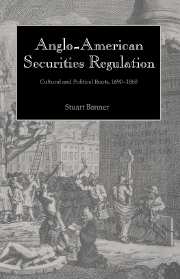Book contents
- Frontmatter
- Contents
- Selected statutes and cases
- Acknowledgments
- Note on dates
- Abbreviations
- Introduction
- 1 English attitudes toward securities trading at its inception, 1690–1720
- 2 The South Sea Bubble and English law, 1720–1722
- 3 English securities regulation in the eighteenth century
- 4 The development of American attitudes toward securities trading, 1720–1792
- 5 American securities regulation, 1789–1800
- 6 American attitudes toward securities trading, 1792–1860
- 7 American securities regulation, 1800–1860
- 8 Self-regulation by the New York brokers, 1791–1860
- Conclusion
- Bibliography
- Index
5 - American securities regulation, 1789–1800
Published online by Cambridge University Press: 23 October 2009
- Frontmatter
- Contents
- Selected statutes and cases
- Acknowledgments
- Note on dates
- Abbreviations
- Introduction
- 1 English attitudes toward securities trading at its inception, 1690–1720
- 2 The South Sea Bubble and English law, 1720–1722
- 3 English securities regulation in the eighteenth century
- 4 The development of American attitudes toward securities trading, 1720–1792
- 5 American securities regulation, 1789–1800
- 6 American attitudes toward securities trading, 1792–1860
- 7 American securities regulation, 1800–1860
- 8 Self-regulation by the New York brokers, 1791–1860
- Conclusion
- Bibliography
- Index
Summary
The first decade of organized securities trading in the United States saw governments experiment with three types of regulation. Early on, the federal government attempted to ban what would today be called insider trading in the public debt, and to tax transfers of securities. These efforts will be discussed in section I. The two states with the leading securities markets, New York and Pennsylvania, both responded to the crash of 1792 with legislative attempts to prohibit certain kinds of speculative trading. Section II will describe these responses, and will then trace their effects on the market and in the courts over the first half of the nineteenth century. Securities trading simultaneously raised all sorts of basic legal questions that had little to do with the crash, questions concerning how new types of routine transactions would be handled and how the new institution would fit into older legal categories. The answers provided by state legislatures and courts in the 1790s, and the effects those early choices had on the law in the first half of the nineteenth century, will be discussed in section III. Some of the discussion of later developments in sections II and III necessarily runs a bit ahead of the chapter's chronological focus, and thus requires mentioning institutional developments (such as the formation of the New York Stock & Exchange Board) that will not be fully described until later chapters.
- Type
- Chapter
- Information
- Anglo-American Securities RegulationCultural and Political Roots, 1690–1860, pp. 161 - 189Publisher: Cambridge University PressPrint publication year: 1998

